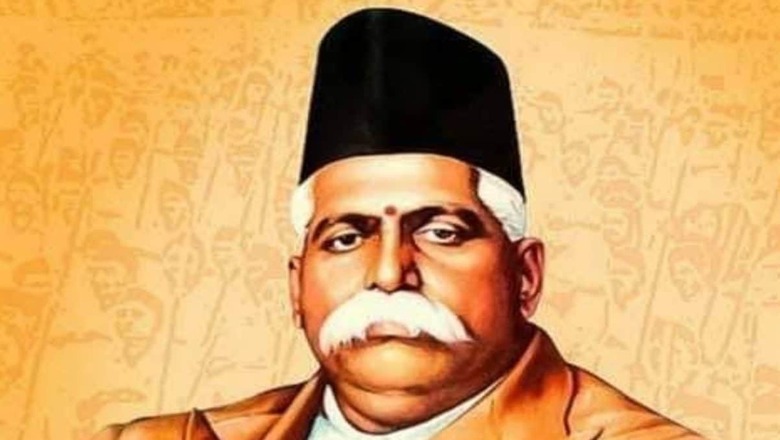
views
Dr Keshav Baliram Hedgewar, who later became one of the most worshipped figures of Bharat, was born on the auspicious Ugadi (New Year) day, in the year Virodhi, 1811 of the Shaka Era, which corresponds to April 1, 1889. He was born in the early morning hours to a Telugu family of Deshastha Brahmins from the Shakala branch, following the Asvalayana Sutra of the Rigveda. Their gotra was Kashyapa, and their main focus was on learning and transmitting the Vedas.
Many Brahmin families had to leave the Telangana region due to neglect and poverty under the Mughals. Some of these families chose to settle in Nagpur, as the Bhonsle rulers were great supporters of Vedic learning. One such family was the great-grandfather of Hedgewar, Baliram Pant. Since his childhood, Hedgewar was deeply affected by the mistreatment of Indians by the British. He often refused to salute the Union Jack during school and public events, believing that his loyalty was only to Bharat Mata, whom he held in high regard, much like his own mother. He promoted the pride of ‘Vande Mataram’ among the student circles in Nagpur, defying the orders of education inspectors and other British officials. During those times, Vande Mataram was the rallying cry of Indians seeking liberation, and the Indian National Congress (INC) was still in its early stages of infancy under colonial rule. Nagpur, rather than the Presidencies or any other location, was the focal point of the nationalist movement at that time.
In 1910, Hedgewar departed for Calcutta, a city he had always held in high regard, to pursue his medical studies. He greatly admired the revolutionaries in Calcutta, who had long been challenging the empire. He drew inspiration from their fight for the liberation of Bharat Mata from the colonial clutches. His interactions with students from all over India and exposure to the diverse cultures of our nation solidified his devotion to Bharat Mata.
During his college years in 1913, Hedgewar joined forces with the Missionaries of Ramakrishna Mission to assist in combating the devastating floods in the Damodar River. The deadly cholera outbreak that plagued India during those years claimed thousands of lives. He selflessly dedicated himself to serving the people during those trying times. His time in Calcutta was a period of enlightenment, as his regular engagements with distinguished individuals and patriotic organisations in the city shaped his intellect. Hedgewar successfully passed his final examination in 1914 and obtained the LMS degree. Following the required practical training period as necessitated by the statutes of that time, he completed the course on July 9, 1915. Despite receiving a lucrative job offer in one of the British dominions, Hedgewar declined, as his mind was now set on a path of dedicated human service.
The colonial government introduced the bogus Indian medical degree bill to penalise nationalist institutions that opposed the British government. Despite allowing graduates from nationalist colleges to practice, their degrees were deemed invalid. This marked Dr Hedgewar’s initial involvement in organised protests. He orchestrated a massive public gathering in Calcutta, with prominent national leader Surendranath Banerjee presiding over the event. The resolution passed at the meeting clearly articulated the public’s demands. As a result of the protests’ effectiveness, the government relented and agreed to recognise all medical graduates following a symbolic examination. This was the first time Dr Hedgewar led public protests against colonial policy and was instrumental in reshaping the policy.
Dr Hedgewar, the organiser, was thus born.
Following his return to Nagpur, he directed his efforts towards revolutionary movements. During that period, the followers of the Tilak school were prominent in the Nagpur Congress and had established the Rashtriya Mandal. All political activities in Nagpur were coordinated through this Mandal, with Hedgewar playing a significant role in the movement. The Rashtriya Mandal made the decision to launch a Hindi weekly publication named Sankalpa. This publication was highly successful in spreading nationalist ideas in Hindi throughout India. To instill the noble ideals that had inspired the lives of great national heroes and scholars in the minds of young individuals, Dr Hedgewar established ‘Rashtriya Utsa Mandal’ aimed at inspiring youngsters to serve the nation.
As he dedicated himself to shaping the minds and intellects of youth towards nation-building, the political landscape of India began to change. Mohandas Karamchand Gandhi, a barrister who had returned from London, gradually emerged as a prominent figure across India. The British government, in response, began to rely heavily on communal tactics to suppress the growing resistance against their rule. This led to the enactment of the Government of India Act of 1919, also known as the Montague Chelmsford reforms, which introduced communal representation in Indian politics and laid the groundwork for partition.
Dr Hedgewar’s independent thinking and perspective were evident during the Nagpur session of the Congress. In one of the meetings, he and his companions drafted a resolution stating, “Our goal is complete independence.” They approached Gandhiji and urged him to have the Congress endorse this resolution. However, Gandhiji was not enthusiastic about accepting the idea of complete independence and instead emphasised ‘Swaraj’ as the immediate priority for the Congress. Furthermore, Gandhiji’s support for merging the non-cooperation movement with the Khilafat movement deeply saddened Hedgewar. Frustrated by the Congress’ slow progress towards independence and the growing communal hatred in the nation, he decided to establish a new organisation.
On the auspicious day of Vijaya Dashami in 1925, young men gathered at Dr Hedgewar’s residence to form an organisation that would later become the world’s largest social non-governmental organisation, known today as the Rashtriya Swayamsevak Sangh (RSS).
Dr Hedgewar built a network of dedicated and selfless swayamsevaks, channelling their energies towards nation-building. Even today, committed, selfless, and motivated swayamsevaks carry forward Hedgewar’s vision, ensuring that his legacy lives on. Much like the organisation he founded, Dr Keshav Baliram Hedgewar continues to inspire generations even to this day more than any other Indian.
Adarsh Kuniyillam is a Parliamentary, policy and political analyst from Kerala who has supported various Members of Parliament. Views expressed in the above piece are personal and solely that of the author. They do not necessarily reflect News18’s views.




















Comments
0 comment